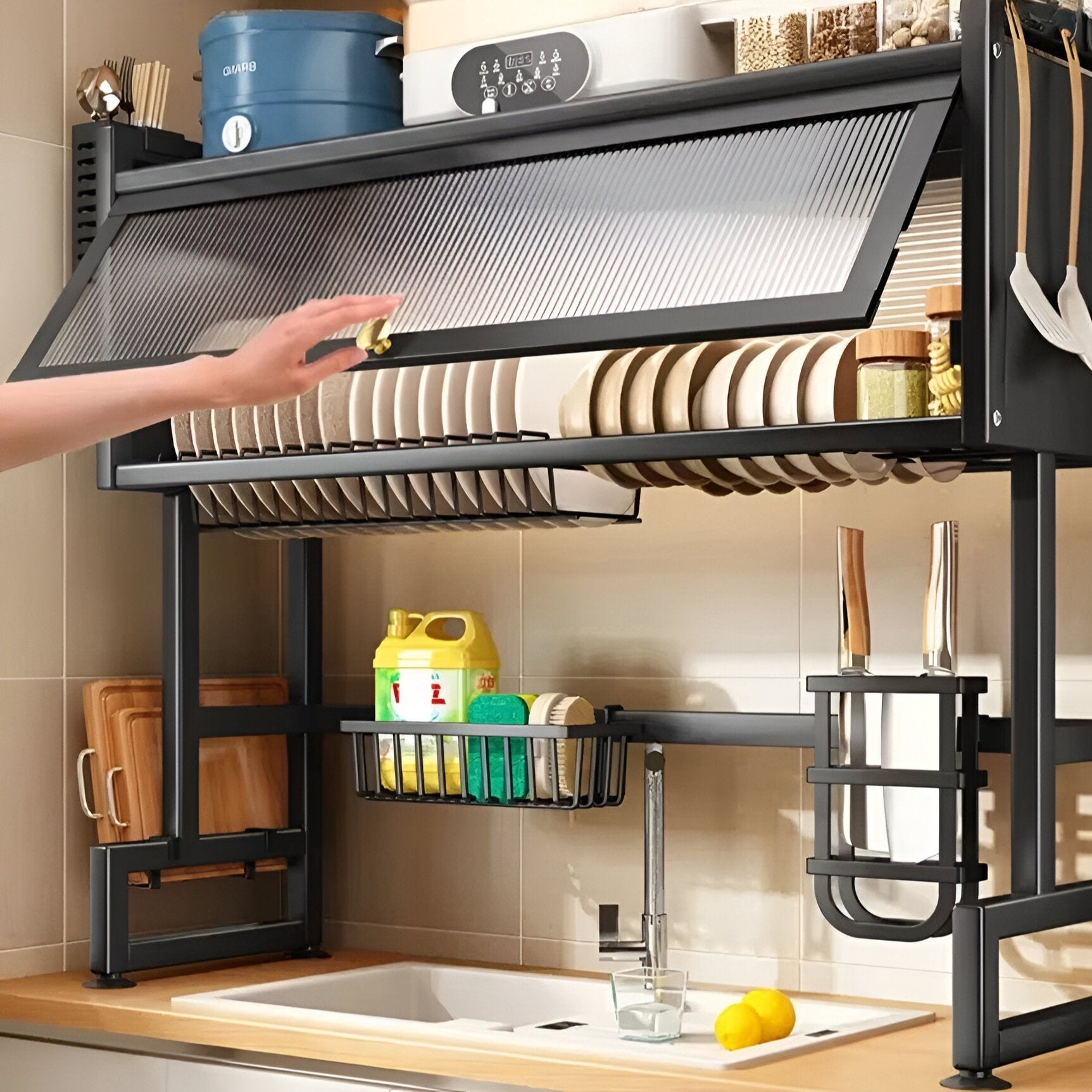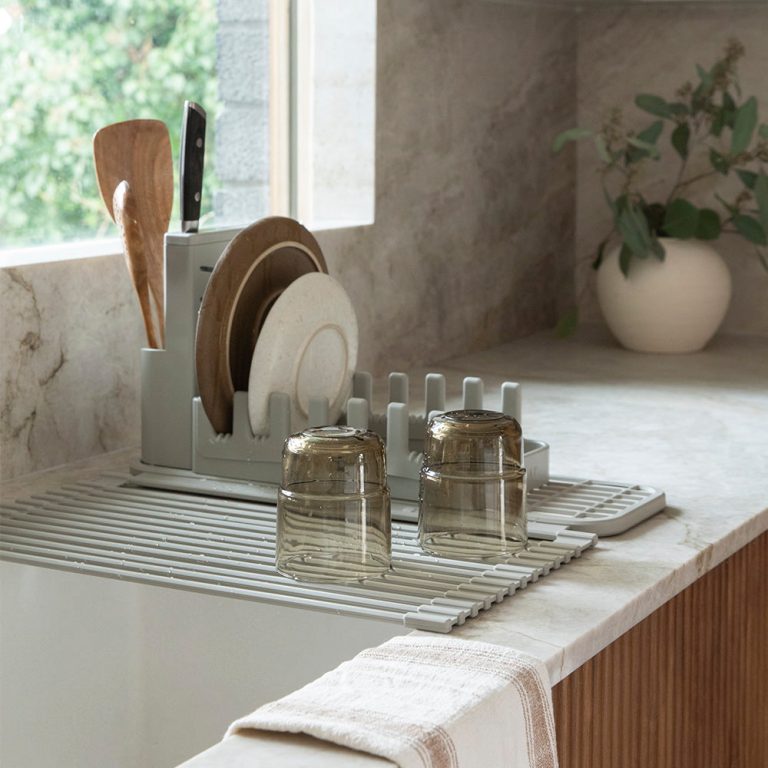Are you tired of cluttered kitchen counters and wet spots everywhere after doing the dishes? You’re not alone.
Choosing the right dish rack can transform your kitchen experience, making it more organized and efficient. But with options like over-the-sink and countertop dish racks, how do you decide which is best for you? This decision isn’t just about aesthetics; it’s about functionality, space optimization, and ease of use.
Imagine effortlessly freeing up counter space or having all your dish-drying needs conveniently placed over the sink. Which scenario resonates with you? As you read on, you’ll uncover the benefits and drawbacks of each type, helping you make an informed choice that fits your kitchen style and needs. Dive in, and let’s find the perfect dish rack solution for you!
Comparison Of Design And Structure
Choosing the right dish rack for your kitchen is crucial for both functionality and aesthetics. The design and structure of dish racks can significantly impact how you manage space and maintain your kitchen’s style. Over-the-sink and countertop dish racks offer different benefits, and understanding their design and structure can help you make a choice that perfectly fits your needs.
Space Utilization
Over-the-sink dish racks maximize space by utilizing the area above your sink. They hang over the sink, allowing water to drip directly into it, saving counter space. This design is ideal for small kitchens where counter space is limited.
Countertop dish racks, on the other hand, occupy a portion of your counter. They come in various sizes, offering flexibility in arrangement. You can move them around as needed, which is great if you like to change your kitchen layout often.
Think about your kitchen’s layout. Do you have enough counter space, or do you need to preserve every inch? Your answer might lead you to one design over the other.
Material And Build Quality
Material plays a big role in the durability and appearance of dish racks. Over-the-sink racks are often made from stainless steel, which is resistant to rust and ideal for wet environments. This ensures longevity and less maintenance.
Countertop racks can be made from plastic, wood, or metal. Each material offers different benefits. Plastic is lightweight and easy to clean, while wood adds warmth and style, and metal provides strength.
Consider what’s important for your kitchen: Is it durability, aesthetics, or ease of cleaning? Each material offers something unique.
Have you ever had a dish rack that rusted quickly or stained your countertop? Choosing the right material can save you from these hassles.
As you ponder these options, think about what matters most to you in your kitchen. Is it maximizing space, ensuring durability, or enhancing style? Your kitchen habits can guide you to the perfect choice.
Capacity And Size
Over-the-sink dish racks save counter space, ideal for small kitchens. Countertop racks offer more capacity, fitting larger families. Choose based on space and needs.
When choosing between over-the-sink and countertop dish racks, understanding the capacity and size of each option is crucial. The right dish rack can make a significant difference in your kitchen’s efficiency and organization. Let’s dive into how these two types of dish racks differ in terms of capacity and size, helping you make an informed decision for your kitchen needs.Number Of Dishes
Over-the-sink dish racks generally offer more space for your dishes. They can accommodate a variety of items, from plates and bowls to pots and pans, without taking up precious counter space. If you frequently cook or have a large family, this type of rack might be the perfect solution. Countertop dish racks, on the other hand, tend to be more limited in capacity. They are ideal for smaller households or those who don’t accumulate many dishes between washes. Think about your dishwashing habits—do you need a rack that can handle a weekend’s worth of dishes, or just a day’s?Adaptability To Different Kitchen Sizes
The adaptability of a dish rack to your kitchen’s size is another important consideration. Over-the-sink racks are great for small kitchens with limited counter space, as they utilize the area above the sink. This design can free up valuable counter space for food prep or other tasks. Conversely, countertop dish racks fit well in larger kitchens where counter space is not an issue. They can be placed conveniently near the sink for easy loading and unloading. Consider how much counter space you have and how you usually use it—would a countertop rack enhance your workflow, or hinder it? Having experienced both types, I found that an over-the-sink rack was a game-changer in my tiny apartment kitchen. It kept my counters clear and my dishes organized. What about you—what’s your kitchen setup like, and how could a dish rack improve your daily routine?Ease Of Installation
Choosing the right dish rack involves considering its ease of installation. Some people prefer quick setups. Others might have more time to dedicate. Both over-the-sink and countertop dish racks offer different installation experiences. Understanding the setup process and required tools can guide your decision.
Setup Process
Over-the-sink dish racks often come pre-assembled. Simply adjust them to fit over your sink. Ensure stability and balance for safety. Countertop dish racks require placement on a flat surface. Arrange the parts according to the instructions. This setup is generally straightforward. Both types prioritize user-friendly setups.
Required Tools
Over-the-sink racks usually need no tools. They rely on adjustable components. This feature makes them convenient. Countertop racks might need basic tools. Sometimes, a screwdriver for minor adjustments. Always check the manufacturer’s guide. It ensures you have everything ready. Having the right tools saves time and effort.

Credit: www.paragonfaucets.com
Maintenance And Durability
Choosing the right dish rack involves more than just design and size. Understanding maintenance and durability is key. This ensures your investment lasts longer. Over-the-sink and countertop dish racks differ in their upkeep and lifespan. Let’s explore these aspects in detail.
Cleaning Requirements
Over-the-sink racks often gather less dirt. They hang above the sink, reducing contact with food debris. Simply rinse them under running water. Mild soap keeps them spotless. Countertop dish racks need more attention. They sit on surfaces, collecting spills and crumbs. Regular cleaning with a damp cloth is necessary. Avoid harsh chemicals. They can damage the rack’s finish.
Longevity And Wear
Durability varies between the two types. Over-the-sink racks face less wear. They are elevated and away from daily traffic. This reduces scratches and dents. Made of stainless steel, they resist rust. Countertop racks endure more stress. They are constantly moved and adjusted. Plastic components may break over time. Frequent use might affect their stability.
Price Comparison
Choosing between an over-the-sink and a countertop dish rack can be more than just a matter of space. Price is a significant factor that influences your decision. Each type of dish rack comes with its unique pricing structure, which can impact your budget and overall satisfaction with the purchase. Let’s dive into the cost elements to help you make an informed choice.
Initial Cost
When you first look at the price tag, countertop dish racks usually start at a lower price point. You can find budget-friendly options for as little as $20, offering basic features and compact designs. These are perfect for small kitchens where space is a concern.
On the other hand, over-the-sink dish racks often have a higher initial cost. They can range from $40 to $100, depending on their size and the materials used. Stainless steel models, while more expensive, promise durability and a sleek look. Have you ever bought a cheap dish rack only to replace it a few months later? Investing a bit more upfront can save you money in the long run.
Value For Money
Is the higher price of an over-the-sink rack worth it? Many users find that these racks offer more value for money. Their design allows for efficient drainage directly into the sink, saving you time and effort in drying dishes. Plus, they free up valuable countertop space.
Countertop racks, while cheaper, might require additional trays to catch water, leading to extra costs. However, if you’re someone who frequently rearranges your kitchen setup, their portability could be a major benefit. Have you ever rearranged your kitchen, only to find a permanent fixture doesn’t fit anymore? Countertop racks offer flexibility that some may find invaluable.
In the end, the choice depends on your priorities. Would you prefer a higher upfront investment for long-term convenience, or a lower initial cost with flexible options? Consider your kitchen habits and space constraints to decide which dish rack provides the best value for your money.

Credit: www.amazon.com
User Experience
The user experience of dish racks can greatly affect daily kitchen tasks. Both over-the-sink and countertop dish racks offer unique benefits. Choosing the right one can make your kitchen routine more efficient. Let’s delve into the convenience and customer feedback of each type.
Convenience
Over-the-sink dish racks save counter space. They allow water to drip directly into the sink. This means less mess and easier cleanup. These racks are ideal for small kitchens with limited space.
Countertop dish racks are easy to access. They can be placed anywhere on the counter. This flexibility is useful for larger kitchens. You can position them near the dishwasher for easy unloading.
Customer Feedback
Many users praise over-the-sink racks for their space-saving design. They enjoy the clutter-free counter. Feedback often highlights the ease of cleaning and maintenance.
Countertop racks receive positive remarks for their versatility. Users appreciate the ability to move them as needed. Reviews often mention the extra storage space for larger dishes.
Aesthetic Appeal
Choosing between over-the-sink and countertop dish racks involves aesthetic considerations. Both options offer unique design elements to enhance your kitchen’s look. The right dish rack can blend seamlessly with your kitchen decor, adding style to functionality.
Design Options
Over-the-sink dish racks often feature sleek, modern designs. Their minimalist lines work well in contemporary spaces. Countertop dish racks come in various shapes and sizes. They can be more ornate, matching different kitchen styles.
Materials play a key role in design. Stainless steel offers a clean, polished look. Wooden racks provide a warmer, rustic feel. Plastic options can be colorful, adding a playful touch. Each material brings a different aesthetic to your kitchen.
Integration With Kitchen Decor
Over-the-sink racks integrate easily into kitchens with open layouts. They keep counters clear, maintaining a tidy appearance. This option suits kitchens where space is a premium.
Countertop racks can be a focal point. Their design can complement kitchen elements like cabinets and countertops. Choosing the right color and material enhances overall decor harmony.
Consider your kitchen’s color scheme. Match or contrast the dish rack for visual interest. Balance form and function for a cohesive kitchen look.
Environmental Impact
The environmental impact of dish racks is often overlooked. Choosing the right type can contribute to sustainability. Examining the materials used is crucial for eco-friendly decisions. Here, we delve into the sustainability and materials of over-the-sink and countertop dish racks.
Sustainability
Over-the-sink dish racks often consume less space. They maximize existing resources without needing extra countertop space. This design supports efficient water drainage back into the sink. Countertop racks, on the other hand, can be less efficient. They may require additional space and materials for water collection trays. Choosing the right rack impacts your kitchen’s carbon footprint.
Materials Used
Materials play a significant role in environmental impact. Stainless steel racks are durable and recyclable. They resist rust and last longer, reducing waste. Plastic racks are less sustainable. They often degrade faster and aren’t easily recyclable. Bamboo racks offer a natural alternative. They are biodegradable and renewable but may require more maintenance.
Consider the materials carefully. Aim for sustainable options that align with your values. Your choice can make a difference in preserving the environment.
Choosing The Right Option
Deciding between over-the-sink and countertop dish racks can impact your kitchen space and efficiency. Over-the-sink racks save counter space, while countertop versions offer easy access and mobility. Choose based on your kitchen layout and personal needs for optimal convenience.
Choosing the right dish rack can feel overwhelming, especially with so many options available. The two most popular choices are over-the-sink and countertop dish racks. Each has its own unique benefits and drawbacks. Your decision should align with your personal needs and your kitchen’s layout. Let’s look at how you can make the best choice for your home.Assessing Personal Needs
First, think about how often you use your dish rack. If you cook frequently and have a family, you might need a larger rack. A small apartment dweller may find a compact design more practical. Consider what kind of dishes you typically wash. If you use a lot of large pots and pans, you’ll need a rack with enough space to accommodate them. Smaller racks might work if you mainly wash plates and cutlery. Think about the materials as well. Stainless steel racks are durable and rust-resistant, but they may be heavier. Plastic racks are lighter but may not last as long. Which material matches your lifestyle?Considering Kitchen Layout
Look at your kitchen space. If your sink area is often cluttered, an over-the-sink dish rack could help save valuable counter space. These racks use the area above your sink, allowing water to drip directly into it. On the other hand, countertop racks provide more versatility. You can place them wherever you have space and move them if needed. This option might be ideal if your kitchen counters are spacious. Measure your sink and counter areas to ensure the rack fits well. A rack that’s too large can make your kitchen feel cramped, while a too-small rack might not meet your needs. Have you thought about how these factors affect your choice? Lastly, consider aesthetics. Your dish rack is part of your kitchen’s decor. Choose one that complements your style and adds to the overall look of your space. What does your kitchen say about you?
Credit: www.amazon.com
Frequently Asked Questions
Why Use Over The Sink Dish Rack?
An over the sink dish rack saves space, keeps countertops dry, and provides easy access for dishwashing tasks. It allows water to drip directly into the sink, reducing mess. This organization tool enhances kitchen efficiency and cleanliness while maximizing limited counter space.
Are Drying Racks Worth It For Dishes?
Yes, drying racks are worth it for dishes. They help air-dry dishes efficiently, saving time and energy. Drying racks also prevent water spots and reduce the risk of bacteria growth. They keep your kitchen organized and clutter-free. Choose a durable, space-efficient design for best results.
What Is The Best Alternative To A Dish Rack?
A microfiber drying mat is an excellent alternative to a dish rack. It absorbs water efficiently and saves space.
Which Plate Rack Is The Best?
The best plate rack depends on your needs. Consider durability, size, material, and design. Stainless steel options offer longevity and style. Wooden racks provide a rustic feel. Check online reviews for popular brands like Simple Houseware or Yamazaki. Choose a rack that fits your kitchen space and complements your decor.
Conclusion
Choosing between over-the-sink and countertop dish racks depends on your needs. Space is key. Over-the-sink racks save counter space. Great for small kitchens. Countertop racks are easy to access and move. Ideal for big families. Consider your kitchen layout. Think about the number of dishes you use daily.
Both options have their benefits. Balance your space, style, and convenience. Decide what suits your lifestyle best. Whether saving space or needing flexibility, pick what works for you. Happy dish drying!


